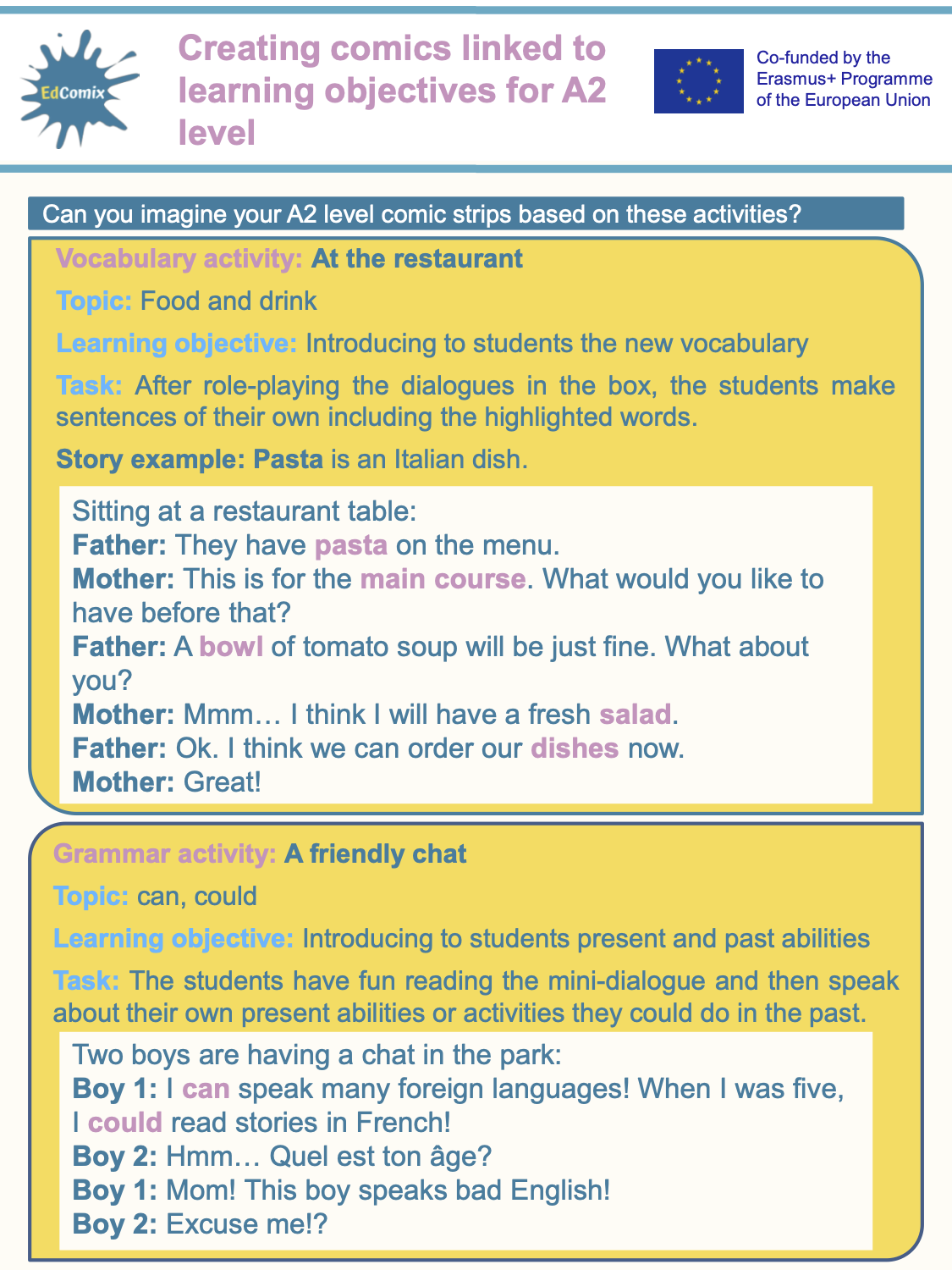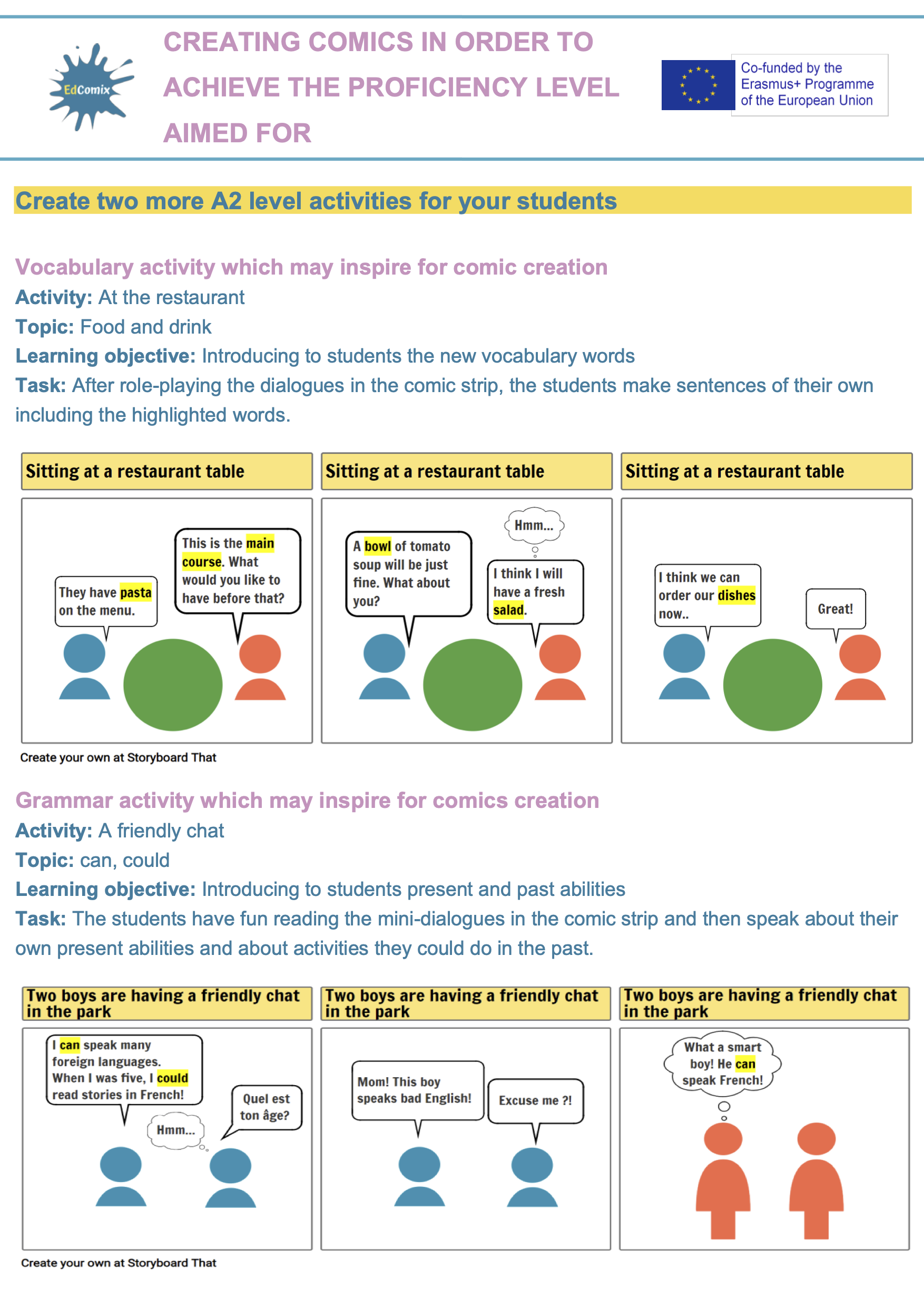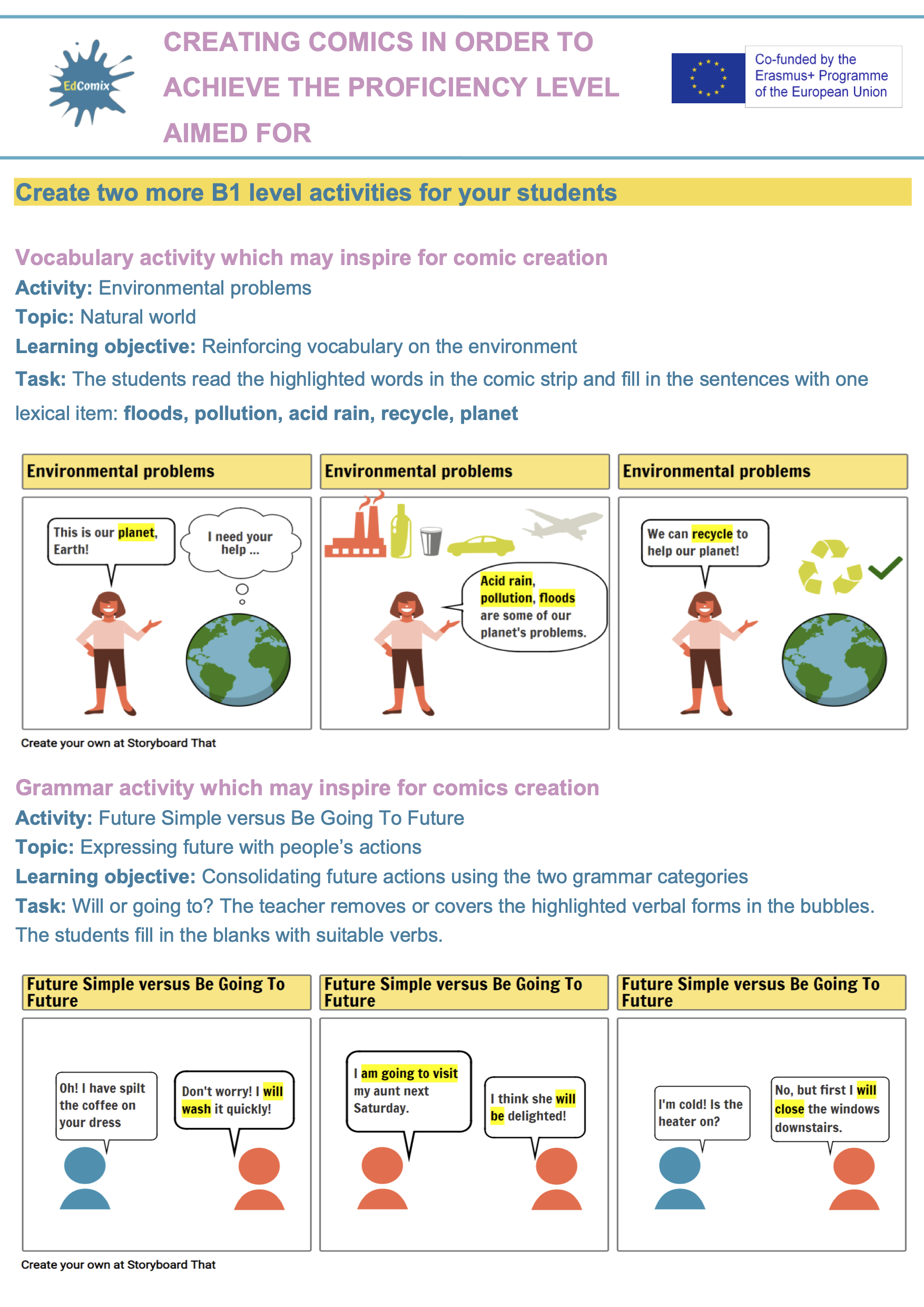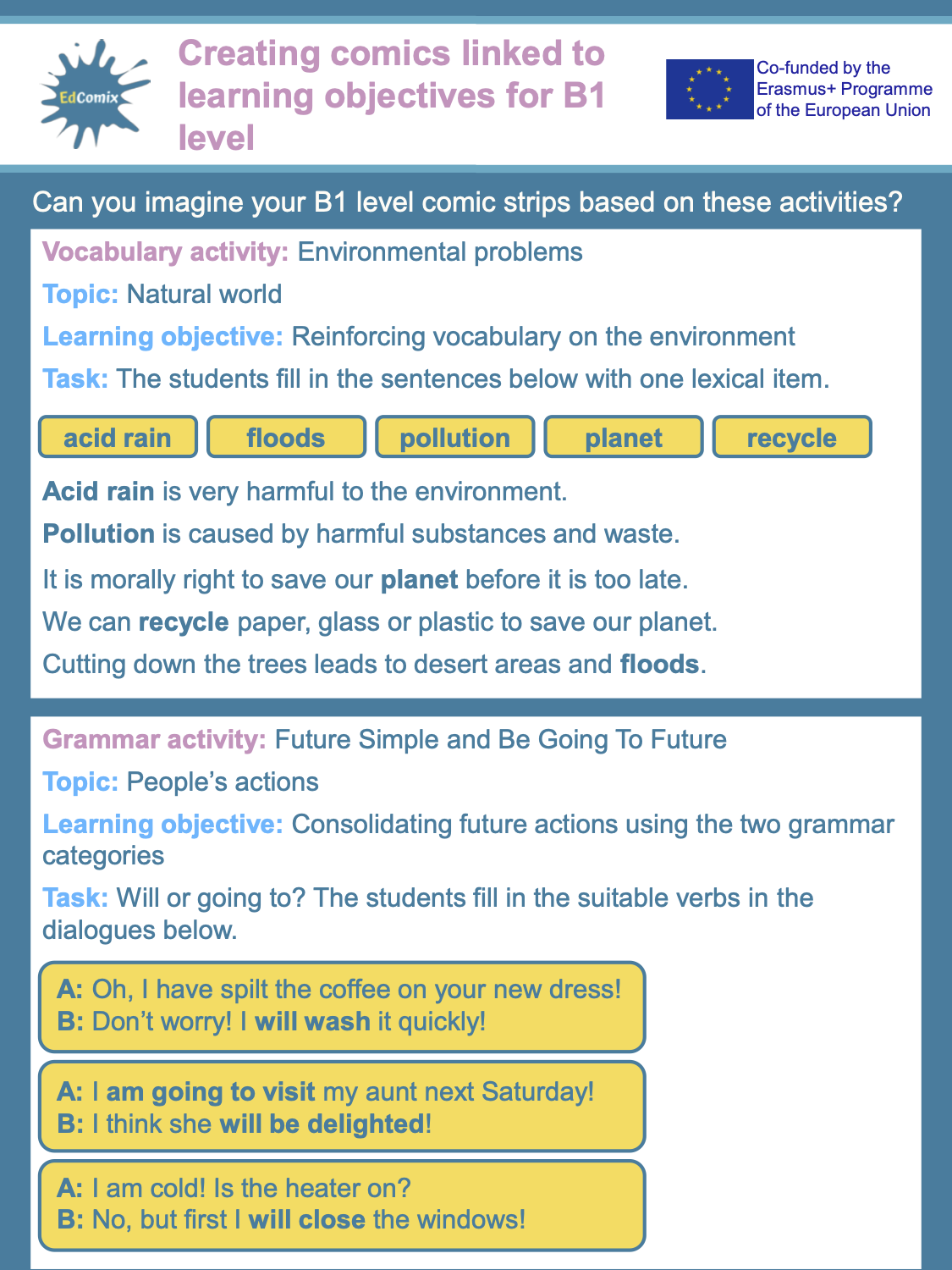
HOW TO ACHIEVE LEARNING OBJECTIVES DESIGNED FOR A2 AND B1 CEFR LEVELS
|
Duration: 60 minutes Objectives: The objective of this lesson is to help learners obtain a comprehensive approach to language proficiency for CEFR levels A2 and B1 Desirable outcomes and competences: By the end of the lesson, the learners will be able to:
|
General language descriptors for A2 and B1 CEFR levels through language activities and skills
The CEFR indicates what students can attain through five language skills which offer referential coordinates to place learners according to the communicative approach involved, in order to receive and/or produce messages in linguistic activities. The language activities for enhancing learning and assessment are, according to the Companion volume of CEFR 2020, as follows:
- Reception: aural (listening), visual (reading) and audio-visual reception
- Interaction: oral interaction, written interaction and online interaction
- Production: oral (speaking) and written (writing)
- Mediation[1]: oral (interpretation) and written (translation)
Language learning basically starts with five language skills which describe what learners can do when they are in a specific communicative situation:
- Spoken interaction
- Spoken production
- Listening
- Reading
- Writing
Users and learners are most likely to perform using the descriptors’ scale to calibrate their language level and, in this respect, they may read CEFR (2001) section 3.7: “How to read the scales of illustrative descriptors” (p. 36), and Section 3.8 (p. 37): “How to use the scales of descriptors of language proficiency”. Teachers who provide students with specific tasks through motivating learning activities to develop these skills will eventually harvest the rewards of proper language acquisition. With comics, language does not communicate ‘at only one level, in terms of information being sought or given’ (McRae, 1991, p. 3), instead it ‘engages the imagination’ (ibid.) of the receiver, thus producing representations on people, events, locations, and socio-cultural backgrounds. In compliance with the CEFR language standards for A2 and B1 levels, the proficiency language descriptors are presented below, so that teachers may set their own target goals when designing class activities (COE, 2020, p.175).
Descriptors for A2 level (spoken interaction, spoken production, listening, reading, writing)
A2 LEVEL, BASIC USER
|
Descriptors for B1 level (spoken interaction, spoken production, listening, reading, writing)
B1 LEVEL, INDEPENDENT USER
|
Distinguishing features between the two levels
Level A2, also referred to as ‘Basic level’, ‘Elementary’ or ‘Waystage’, is where students have already acquired the basic English language and can use it to communicate simple needs, with elementary vocabulary and commonly-used expressions with a limited range of contexts. An A2 level gives students the ability to network with English-speaking friends on familiar topics and routine activities which they or their family perform. Level A2 helps teachers assess simple everyday interactions in the form of greetings, reaction to news, asking and answering questions about jobs, hobbies and leisure activities, meeting arrangements, making simple transactions in public spaces (shops, banks, post offices), using public transport and asking or giving directions, travelling and holiday planning.
Level B1 corresponds to independent users and reflects the ‘Threshold’ or ‘Intermediate’ language mastery within a range of contexts. At this stage, learners are beyond the basics and are able to maintain interaction, coping flexibly with daily activities and non-routine information. Students may indulge in informal discussions with friends, make complaints, take the initiative in an interview, maintain conversations on familiar topics, talk and write about personal dreams and ambitions for the future, education and future training, healthy lifestyles, making friends on social media and can conversationally manage most situations that are likely to appear when travelling, ‘though pausing for grammatical and lexical planning’ (COE 2020, p. 173). At B1 level, students have already achieved the basics and now are able to understand and produce simple connected text regarding messages, reviews, reports, emails, articles, stories and short essays.
With a view to the communicative language competences, the CEFR-Companion volume (COE 2020, pp. 130-131) presents descriptors for the linguistic domain which includes lexical, grammatical (morphological, syntactic), semantic, orthographic, ortoepic and phonological knowledge. Learners need to acquire the lexical competence (ability to use the vocabulary of a language, i.e. words and fixed expressions) together with the grammatical competence (the ability to express meaning through well-formed phrases and sentences).
The descriptors for the general linguistic range pertaining to the two levels referred to in our project are:
For A2, the user:has a repertoire of basic language which enables them to deal with everyday situations with predictable content, though they will generally have to compromise the message and search for words/signs. can produce brief, everyday expressions in order to satisfy simple needs of a concrete type (e.g. personal details, daily routines, wants and needs, requests for information). can use basic sentence patterns and communicate with memorised phrases, groups of a few words/signs and formulae about themselves and other people, what they do, places, possessions, etc. has a limited repertoire of short, memorised phrases covering predictable survival situations; frequent breakdowns and misunderstandings occur in non-routine situations. |
For B1, the user:has a sufficient range of language to describe unpredictable situations, explain the main points in an idea or problem with reasonable precision and express thoughts on abstract or cultural topics such as music and film. has enough language to get by, with sufficient vocabulary to express themselves with some hesitation and circumlocutions on topics such as family, hobbies and interests, work, travel and current events, but lexical limitations cause repetition and even difficulty with formulation at times. |
Each act of language occurs under specific circumstances or domains which the CEFR (2001, p. 45) identifies in terms of purposes for language learning in general contexts, such as: the personal domain (family and relatives, friends, home), the public domain (public spaces and personnel, public authorities, political bodies, transport), the occupational domain (jobs, professions, employers and employees), the educational domain (educational institutions and teaching staff). Within each domain there are themes or topics on which students build their language acts through strategies in order to meet the learning objectives established by assessors (CEFR 2001, p. 52):
- personal identification
- house and home, environment
- daily life
- free time, entertainment
- travel
- relations with other people
- health and body care
- education
- shopping
- food and drink
- services
- places
- language
- weather

References:
Council of Europe, (2001). Common European Framework of Reference for Languages: Learning, teaching, assessment.Cambridge University Press, Cambridge. Retrieved from: http://ebcl.eu.com/wp-content/uploads/2011/11/CEFR-all-scales-and-all-skills.pdf
Council of Europe, (2020). Common European Framework of Reference for Languages: Learning, teaching, assessment: Companion Volume with New Descriptors. Council of Europe Publishing, Strasbourg. Retrieved from: https://rm.coe.int/common-european-framework-of-reference-for-languages-learning-teaching/16809ea0d4 and https://www.coe.int/en/web/common-european-framework-reference-languages
McRae, J., 1991. Literature with a Small ‘l’. Basingstoke, London: Macmillan.
[1]‘In both the receptive and productive modes, the written and/or oral activities of mediation make communication possible between persons who are unable, for whatever reason to communicate with each other directly. Translation or interpretation, a paraphrase, summary or record, provides for a third party a (re)formulation of a source text to which this third party does not have direct access. Mediation language activities, (re)processing an existing text, occupy an important place in the normal linguistic functioning of our societies.’ (CEFR Section 2.1.3: English p. 14, French p. 18)
HOW TO CREATE COMICS LINKED TO LEARNING OBJECTIVES FOR A2 CEFR LEVEL
Duration: 60 minutes Objectives: The objective of this lesson is to create comics using the linguistic structures (lexical and grammatical) to meet the designed learning objectives, in accordance with the CEFR A2 descriptors. Desirable outcomes and competences: By the end of the lesson, the learners will be able to:
|
Grammar structures for A2 level
The trainees will find in this lesson support and genuine examples for lexical and grammatical categories which they can use in the English activities designed for A2 elementary users. Together with the ‘can-do’ descriptors for this level, the grammar section helps teachers of English pinpoint the key aspects of language and its structural rules in a clear and practical way.
Adjectives – comparative – use of than: ex. The new building was taller than the old one.
Adjectives – superlative: ex. He is the best at English and the most attentive student.
Adverbial phrases of time, place and frequency – including word order (last week, twice a year, under the sea): ex. A beautiful mermaid lived under the sea.
Adverbs of frequency (always, never): ex. My desk mate always reads comic books.
Articles – with countable and uncountable nouns (-, a, an, the): ex. Eagles are endangered birds. She is aRomanian tourist. These are the results for the English exam.
Countables and uncountables (much, many): ex. There is too much sugar in my coffee. There are many comic books in this library.
Gerunds (writing, swimming, playing): ex. I like writing poems.
Modals – have to: ex. I have to be at home by 9 p.m.
Modals – should: ex. You should write a letter to your granny.
Past continuous: ex. We were reading a magazine at 10 a. m. yesterday.
Past simple: ex. The dog ran around the garden ten minutes ago.
Phrasal verbs – common: ex. Our car broke down last week.
Possessives – use of ‘s and s’: ex. John’s pencil, the boys’ bikes
Prepositional phrases: place, time and movement: ex. There is a hairdresser’s across the street.
Prepositions of time: on, in, at ex. on TV, in the classroom, at home
Present continuous: ex. We are writing an exercise now.
Present continuous for future: ex. I am visiting Brussels next month.
Present perfect: ex. Have you read that comic page?
Pronouns: ex. Did you buy this book? Is it yours?
How-questions: ex. How far is the local market? How old are your grand-parents?
Verb + ing or infinitive with like, want-would like: ex. Do you like fishing? I’d like to learn how to play the piano.
Wh-questions: ex. Where is the toilet? What time does the plane take off?
Will, won’t: ex. I will go to bed but I won’t brush my teeth.
Zero and 1st conditional: ex. If ice melts, it becomes water. If it rains tomorrow, I’ll stay at home.
Vocabulary and topics for A2 level
At this level, the vocabulary is mainly related to topics that describe predictable daily routines of immediate personal relevance, basic needs, messages written in simple language, meeting arrangements, simple transactions (e.g. in post offices, bus/railway stations, shops, etc.), simple practical information (e.g. booking a room/a ticket, asking for directions), producing simple descriptions of events, personal experiences or telling a simple, short story, writing short biographies, or keeping a simple logbook or diary.
Online tools for A2 learners
Below we have provided a range of online tools which help teachers design their learning activities based on mainly grammatical and lexical tasks:
Young learners, 7-12 years old
https://www.cambridgeenglish.org/Images/351851-a2-flyers-word-list-2018.pdf (wordlist, pages 33-37)
https://www.cambridgeenglish.org/Images/506166-starters-movers-flyers-word-list-2018.pdf (wordlist,pages 12-16)
https://www.cambridgeenglish.org/Images/357180-starters-movers-and-flyers-handbook-for-teachers-2018.pdf (alphabetic vocabulary list, pages 81-84)
Teenage and adult learners
http://www.englishprofile.org/english-grammar-profile
http://www.englishprofile.org/wordlists/evp
https://www.examenglish.com/index.html
https://www.cambridgeenglish.org/images/506886-a2-key-2020-vocabulary-list.pdf
https://learnenglishteens.britishcouncil.org/vocabulary
https://www.examenglish.com/grammar/a2_grammar.html
https://www.allthingsgrammar.com/cefr-levels.html
https://www.esleschool.com/different-text-types/
https://learnenglish.britishcouncil.org/category/learner-audience/adult-learners
https://learnenglish.britishcouncil.org/skills/speaking/pre-intermediate-a2/giving-instructions
https://www.onestopenglish.com/adults

References
The English Profile Programme, founded by Cambridge University Press and Cambridge English Language Assessment, (n d.). English Grammar Profile. Retrieved from: http://www.englishprofile.org/english-grammar-profile
The English Profile Programme, founded by Cambridge University Press and Cambridge English Language Assessment, (n d.). English Vocabulary Profile. Retrieved from: http://www.englishprofile.org/wordlists
HOW TO CREATE COMICS LINKED TO LEARNING OBJECTIVES FOR B1 CEFR LEVEL
Duration: 60 minutes Objectives: The objective of this lesson is to create comics using the linguistic structures (lexical and grammatical) to meet the designed learning objectives, in accordance with the CEFR B1 descriptors. Desirable outcomes and competences: By the end of the lesson, the learners will be able to:
|
Grammar structures for B1 level
At this linguistic level, the students will have gained sufficient vocabulary, although used with repetitions, to express themselves in unpredictable situations and making use of the grammar categories below. Teachers have guidance in this lesson to design vocabulary and grammar activities for their students as independent users of English.
Adverbs: ex. He works very hard. He is deeply in love with my sister.
Both, either, neither: ex. Neither of the dogs is dangerous.
Broader range of intensifiers – so, such, too, enough: ex. I ate too much ice-cream.
Comparatives and superlatives: ex. I need further information to fill in this form.
Question tags: ex. She’s the prettiest, isn’t she?
Conditionals, 2nd and 3rd: ex. We would have visited her if we had known the address.
Connecting words expressing cause and effect, contrast: ex. Because of the traffic, I arrived late.
Embedded questions: ex. What are they doing? I don’t know what they are doing.
Future continuous: ex. Mary will be sleeping by the time you get home.
Modals – must, can’t deduction: ex. He can’t have planted these roses. He hates gardening.
Modals – might, may, will, probably: ex. My parents may go to work abroad.
Modals – should have, might have, etc.: ex. I should have done my homework!
Modals: must, have to: ex. Why do you have to pretend all the time?
Past continuous: ex. Grandfather was quickly folding the newspaper.
Past perfect: ex. When the phone rang, mother had already parked the car.
Past simple: ex. When was your birthday? Did you throw a party?
Past tense responses: ex. Did you receive the good news? Yes, I did.
Phrasal verbs, extended: ex. She broke up with Peter.
Prepositions of place: ex. The kite is flying up in the sky.
Present perfect continuous: ex. They have been collecting stamps for three years.
Present perfect simple: ex. Have you done your homework yet?
Pronouns: ex. I didn’t tell anyone about the competition.
Reported speech (range of tenses): ex. ‘I went to the party’, John said. John said he had been there.
Simple passive: ex. The burglars will be caught, eventually.
Wh-questions in the past: ex. What did you do last summer in Greece? When was the Second World War?
Will and going to, for prediction: ex. I’ll have a big family and I’ll live in a big house! A hole! He is going to fall in it!
Vocabulary and topics for B1 level
Before creating comics for the English class, teachers may consult in extenso the CEFR vocabulary appropriate to the B1 level which includes receptive vocabulary (to be understood by students during reading or listening skills) and productive vocabulary (to be used during speaking and writing skills).
The following taxonomy is helpful for teachers who create comic strips on topics related to the real world:
- Appliances
- Buildings
- Clothes
- Colours
- Education
- Entertainment and media
- Environment
- Food and drink
- Health, medicine and exercise
- Hobbies and leisure
- House and home
- Language
- Personal feelings, opinions and experiences
- Places: countryside, town and city
- Services
- Shopping
- Sport
- Technology and communications
- The Natural world
- Travel and transport
- Weather
- Work and jobs
Online tools for B1 learners
http://www.englishprofile.org/english-grammar-profile
http://www.englishprofile.org/wordlists/evp
https://www.cambridgeenglish.org/images/506887-b1-preliminary-2020-vocabulary-list.pdf
https://learnenglishteens.britishcouncil.org/vocabulary/advanced-vocabulary
https://www.examenglish.com/grammar/b1_grammar.html
https://www.esleschool.com/different-text-types/
https://learnenglish.britishcouncil.org/business-english/english-for-emails/unit-9-email-etiquette
https://learnenglish.britishcouncil.org/business-english/business-magazine/job-interviews
https://www.onestopenglish.com/adults
References
The English Profile Programme, founded by Cambridge University Press and Cambridge English Language Assessment, (n d.). English Grammar Profile. Retrieved from: http://www.englishprofile.org/english-grammar-profile
The English Profile Programme, founded by Cambridge University Press and Cambridge English Language Assessment, (n d.). English Vocabulary Profile. Retrieved from: http://www.englishprofile.org/wordlists
HOW TO CREATE COMICS IN THE CLASSROOM IN ORDER TO ACHIEVE THE PROFICIENCY LEVELS AIMED FOR
Duration: 60 minutes Objectives: The objective of this lesson is to offer learners guidance to create comics for the English class in order to acquire language proficiency Desirable outcomes and competences: By the end of the lesson, the learners will be able to:
|
Using comics as a reader (decoding text and images)
Decoding text
As reading comprehension refers to the ability to process text, understand its meaning, and to integrate it with what the reader already knows, we shall go further with revealing Day and Park’s (2005) taxonomy on the six types of reading comprehension when teaching a foreign language:
- Literal comprehension, a straightforward meaning where readers perceive the text at a connotative meaning;
- Reorganisation occurs when readers combine different textual pieces for additional understanding;
- Inference requires learners to appeal to their personal knowledge to find the implicitly stated information;
- Prediction combines prior knowledge with understanding in order to predict future actions within a text;
- Evaluation is based on the general perception of the reading material so that readers may offer final judgement or opinion about the text;
- Personal response is an open-ended comprehension of the text used by readers to express their feeling and emotions to the text.
Whenever readers approach a text, they are prone to reconstruct it according to their previous knowledge, beliefs and socio-cultural assumptions. With comics, which are unlike other books, readers are openly facing thelinguistic elements inside conversational panels to produce meaning.
Decoding images
We live in a world dominated by technology and social media, wherever we go, either physically or virtually, we are imbued with visual content, so why not take advantage of this fact for the benefit of learning? The research developed by Clark and Lyons (2004) suggests that visuals have greater impact on readers than ‘exclusively reading words’. To be more accurate, Wright and Sherman (1994) had previously proved that using comic strips inside the classroom allows teachers to promote literacy, higher level thinking and writing skills by simply combining language and art. The pictorial quality of the comics helps readers remember the narrative flow of the sequential panels due to the ligature between images and text, a process which may be expanded into ‘the imagination of the reader’ to create a ‘totally new experience’ (Lardinois et al., 2015, p. 248). Only rarely are comics solely supported by visuals, as pictures may ‘speak’ for themselves by encapsulating quintessential information which nourishes and accompanies the reader to a successful narrative.
Using comics in group work activities
The already beaten path of the teaching effectiveness regarding learning group activities offers learners a challenging and supportive environment. Teachers and trainers need a thorough planning and facilitation when implementing group work successfully, in terms of classroom layout and behavioural conduct so as to create an inclusive atmosphere, learning aims and motivational input to arouse students’ interests and foster progress. They also need to organise a fair division of tasks and indulge in monitoring and assessing group interaction.
Traditional and conservative teachers may say that introducing comics in such activities would be daring or even inappropriate, as comics are but a form of entertainment for teenagers rather than a learning tool and would hardly fit in the school syllabi. Consequently, throughout our project’s pages we have already mapped how comics become a powerful and resourceful tool to enhance learning skills.
As group members, students are guided through attractive reading material that can change students’ attitudes towards reading and writing and help them discover the pleasure of making meaning. By analysing and interpreting visuals, readers can easily follow the storytelling and make inferences. As one of the first elements that students grasp are the illustrations, here is an exercise idea: arranged in small groups, students are required to guess several feelings expressed by the characters on a comic page, e.g. happiness, sadness, joy, in love, anger, fright, etc. They can afterwards read the text in the dialogue boxes to check if they were right.
Speaking activities can be designed for elementary students using simple descriptions of comics images with given support or they may be asked to invent their own characters, thus reinforcing pronouns, adjectives and verbal forms. Students at higher levels of English take turns to tell a story based on comic strips. Storytelling tasks can be extended into biographical stories, where students learn about the work and lives of famous writers, scientists, painters, actors and actresses. Students can use comic strips to visually retell a story they have recently read, alter it, or even create a new one. For (self) assessment, they can be recorded. For instance, your group will create a News Broadcast and must take on one role (Anchor, Sports Reporter, Weather Person, On-the-Scene Correspondent). Once the groups settle, the teacher records their broadcast and then fills in the bullets designed for their roles.
According to Harmer (2001, p. 117), group work ‘increases the amount of talking for individual students.’ Wordless panels may be challenging and also interesting for creative role-playing. Listening to their peers’ self-confidence in oral productions while role-playing, students activate their language knowledge. Teachers can have them listen to a story and challenge students to write it using sequential frames or act out the dialogues to check listening comprehension.
To enhance writing skills, lower levels can start with storyboard templates where they experience the key frame events and contracted text writing before moving to comic pages. Higher levels may be asked to create speech bubbles and include thought bubbles for the characters. It is also the moment when students keen on the film making domain may indulge in mise-en-scène activities as a future career.
Example of reading activity realised for group work:
Pre-Reading: students are presented with a comic strip or page where the bubbles have been removed. Based on the background and characters (appearance, posture, emotions), they are asked to predict the theme or topic of the task.
While-Reading: students may work on various tasks: making connections with their own lives, role-playing, filling the bubbles with newly acquired vocabulary/grammar patterns, developing oral and written skills by summarising a comic strip or panel, answering or asking questions.
After-Reading: completing charts and spider grams, debating, writing a press kit, writing a letter to a comic book character, realising a portfolio in a group work activity, group discussions.
Guidelines on creating comics in the classroom
What do you need to create comics for your English language class? Pens, ink and paper would be enough, traditional artists would answer. Yet, not everybody is endowed with drawing skills; additionally, we live in a digital world where teenagers seem to be revolving around. Reading comics on a screen, as Scott McCloud (2009) declared, is like an ‘infinite canvas’ with multiple directions and possibilities.
Teachers turn themselves into superheroes – figuratively speaking … or not! – when they indulge in motivating learning activities using resourceful tools as comics.
Webcomics can be tailored towards exploring different linguistic paths, for instance creating and juxtaposing meaningful pictures develops vocabulary acquisition. Drilling on grammar patterns is also possible with colourful sequential frames, rather than have students approach it in a traditional way. Below we have provided examples that teach or review lexical items and grammar patterns for the CEFR A2 and B1 linguistic levels. Tune in to our learning creations and discover the marvel(lous) world of comics to add variety to your own lessons through comics!
Comics created for specific learning objectives
You can find here examples of vocabulary and grammar activities designed with the digital creators below, after having settled the learning objectives which help teachers assess their students’ progress at the end of each learning activity.
The comparison degrees of the adjectives through tales with beautiful castles and terrifying dragons, learning new vocabulary based on a student’s room at elementary level and turning into reported speech a colloquial conversation for intermediate users are some language instances where teachers make use of their creativity when designing simple comics for their English classes.
Topic: Comparison degrees for adjectives, A2 level
Comics tool: Storyboard That

Link: https://www.storyboardthat.com
Topic: Vocabulary for room objects, A2 level
Comics tool: Storyboard That at https://www.storyboardthat.com

Link: https://www.storyboardthat.com
Topic: Reported Speech, B1 level
Comics tool: Pixton EDU

Link: https://edu.pixton.com/educators


References
Clark, R.C., Lyons, C. (2004). Graphics for learning: Proven guidelines for planning, designing, and evaluation visuals in training materials. CA: Pfieffer.
Day, R. R. and Park, J-s., 2005. Developing reading comprehension questions. Reading in a Foreign Language Volume 17, No. 1, April 2005, ISSN 1539-0578.
Retrieved from: https://nflrc.hawaii.edu/rfl/April2005/day/day.pdf
Harmer, J. (2001). The Practice of English language teaching. (3rd ed.) Essex: Pearson Education Limited.
Lardinois, A. et al. (2015), eds. Texts, transmissions, receptions: Modern approaches to narratives. Leiden, NL: Brill.
McCloud, S. (2009) [The ‘Infinite Canvas’] Retrieved from: http://scottmccloud.com/4-inventions/canvas/
Wright, G., Sherman, R. (1999). Let’s Create a Comic Strip. Reading Improvement; Summer 1999, Vol. 36 Issue 2, 66-72. Retrieved from:

This project (2019-1-FR01-KA201-062855) has been funded with support from the European Commission. This publication reflects the views only of the author, and the Commission cannot be held responsible for any use which may be made of the information contained therein.
